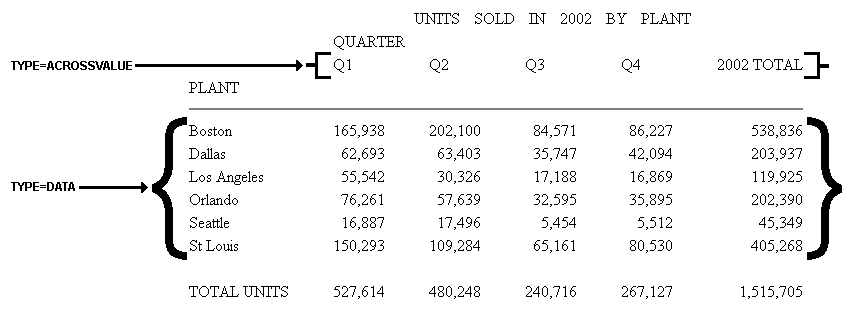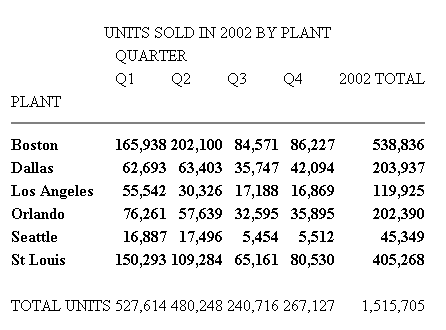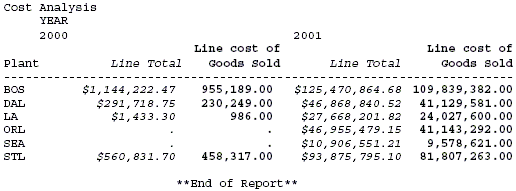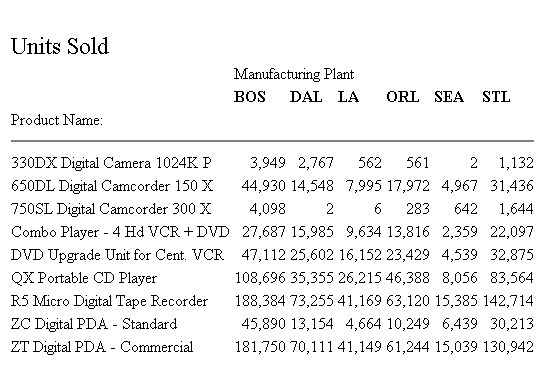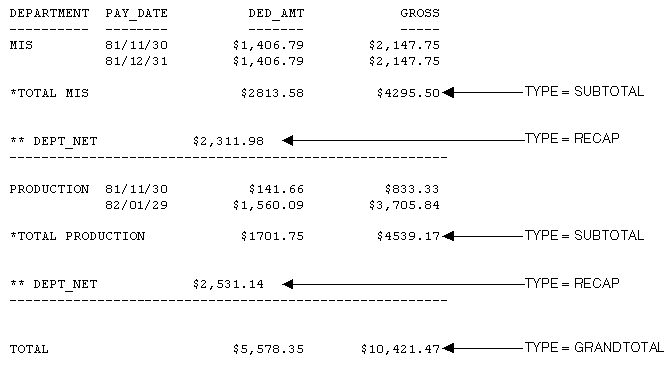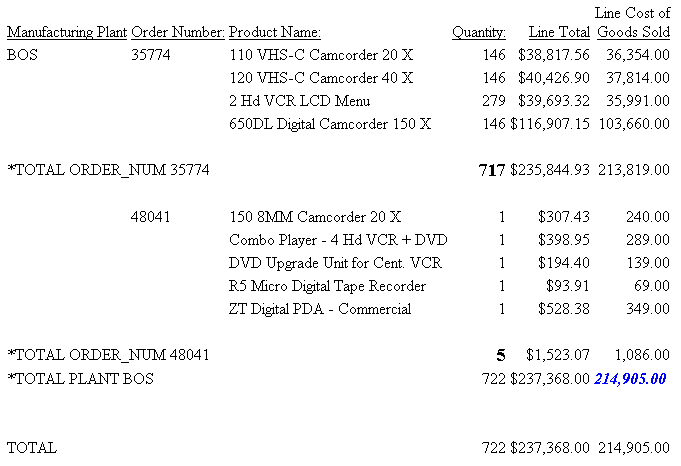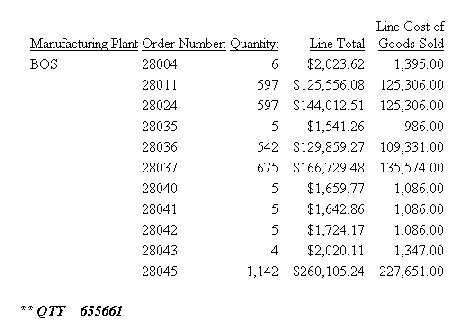TYPE=type, [BY=sortfield] [coltype=column]
where:
- type
-
Identifies a subtotal or total. Select from:
GRANDTOTAL which
is a grand total (generated by COLUMN-TOTAL, SUBTOTAL, SUB-TOTAL,
RECOMPUTE, or SUMMARIZE). See Identifying
a Grand Total for an example.
SUBTOTAL which
is a subtotal (generated by SUBTOTAL, SUB-TOTAL, RECOMPUTE, or SUMMARIZE).
See Identifying
Subtotals for an example.
RECAP which
is a subtotal calculation (generated by ON sortfield RECAP
or ON sortfield COMPUTE). See Identifying
a Subtotal Calculation (RECAP/COMPUTE) for an example.
- BY
-
If you have a request with multiple BY fields, and
two or more have subtotal commands associated with them, you can
identify each field using the BY identifier. This is helpful when
you want to format each subtotal differently or when you want to
format only one subtotal.
You only need to include
the BY identifier if you have multiple BY fields in your request.
- sortfield
-
Specifies the BY field associated with several subtotal
commands of a report. Use the fieldname for the value (BY=fieldname).
- coltype
-
Identifies a specific column to apply formatting.
When you include the COLUMN or ACROSSCOLUMN identifier in your declaration,
only the subtotal values receive the formatting, the labeling
text will not. Values can be:
COLUMN which
is a display column (generated by PRINT, LIST, SUM, or COUNT) or
a computed column (generated by COMPUTE).
ACROSSCOLUMN where
every instance of a display or computed column is repeated across
a horizontal sort (ACROSS) row.
If there are several
columns being totaled or subtotaled by one command, and you do not
specify a column in the StyleSheet, the formatting will be applied
to the totals or subtotals for all of the columns. It will
also be applied to the labeling text for the total and subtotal
values.
- column
-
Specifies the column whose totals or subtotals you
wish to format. For a list of values, see Identify
an Entire Column.
Example: Identifying a Grand Total
The following illustrates how to identify
a grand total in a report request. In this example, we only want
to format the grand total value for the LINE_COGS field, so the COLUMN
attribute is included in the StyleSheet declaration. The grand total
in this request is generated by COLUMN-TOTAL. The relevant StyleSheet
declaration is highlighted in the request.
Note:
- To style the entire grand total row,
remove the COLUMN attribute from the StyleSheet declaration.
- To produce
the same results you can alternatively use the values N5, P5, or
C3 for the COLUMN attribute in the StyleSheet declaration.
TABLE FILE CENTORD
SUM QUANTITY LINEPRICE LINE_COGS AND COLUMN-TOTAL
BY ORDER_NUM BY PRODNAME
WHERE ORDER_NUM EQ '48053' OR '48798'
ON TABLE SET PAGE-NUM OFF
ON TABLE SET STYLE *
TYPE=REPORT, GRID=OFF,$
TYPE=GRANDTOTAL, COLUMN=LINE_COGS, STYLE=BOLD, SIZE=11,$
ENDSTYLE
END
The output is:
Example: Identifying Subtotals
The following illustrates how to identify
subtotals in a report request. In this example, only subtotal values
in the QUANTITY and LINE_COGS fields are formatted, so the COLUMN attribute
is included in the StyleSheet declarations.
Also, since there are two SUBTOTAL commands
associated with two of the three BY fields (PLANT and ORDER_NO),
the BY attribute is also included in each declaration to ensure
the formatting is applied to the correct value. The relevant StyleSheet
declarations are highlighted in the request.
Note:
- To style an entire subtotal row, remove
the COLUMN and BY attributes from the StyleSheet declaration.
- To produce
the same results you can, alternatively, use the values COLUMN=N6, COLUMN=P6,
or COLUMN=C3 for the COLUMN=LINE_COGS attribute.
- To produce
the same results you can, alternatively, use the values COLUMN=N4, COLUMN=P4,
or COLUMN=C1 for the COLUMN=QUANTITY attribute.
TABLE FILE CENTORD
SUM QUANTITY LINEPRICE LINE_COGS AS 'Line Cost of, Goods Sold'
BY PLANT
BY ORDER_NUM
BY PRODNAME
ON PLANT SUBTOTAL
ON ORDER_NUM SUBTOTAL
WHERE ORDER_NUM EQ '35774' OR '48041'
WHERE PLANT EQ 'BOS'
ON TABLE SET PAGE-NUM OFF
ON TABLE SET STYLE *
TYPE=REPORT, GRID=OFF,$
TYPE=SUBTOTAL, BY=PLANT, COLUMN=LINE_COGS, STYLE=BOLD+ITALIC,
COLOR=BLUE,$
TYPE=SUBTOTAL, BY=ORDER_NUM, COLUMN=QUANTITY, STYLE=BOLD, SIZE=11,$
ENDSTYLE
ENDThe output is:
Example: Identifying a Subtotal Calculation (RECAP/COMPUTE)
The following illustrates how to identify
a subtotal calculation created with a RECAP or COMPUTE phrase. In
this example, the subtotal calculation is generated with ON PLANT RECAP
QTY/F6=QUANTITY. The relevant StyleSheet declaration is highlighted
in the request.
Note: If
there is more than one RECAP or COMPUTE field in your request, you can
distinguish them by adding BY=fieldname to the StyleSheet
declaration.
TABLE FILE CENTORD
SUM QUANTITY LINEPRICE LINE_COGS AS 'Line Cost of, Goods Sold'
BY PLANT BY ORDER_NUM
ON PLANT RECAP QTY/F6=QUANTITY;
WHERE PLANT EQ 'BOS'
WHERE ORDER_NUM LT '56098'
ON TABLE SET PAGE-NUM OFF
ON TABLE SET STYLE *
TYPE=REPORT, GRID=OFF, $
TYPE=RECAP, STYLE=BOLD+ITALIC, $
ENDSTYLE
END
The output is:
